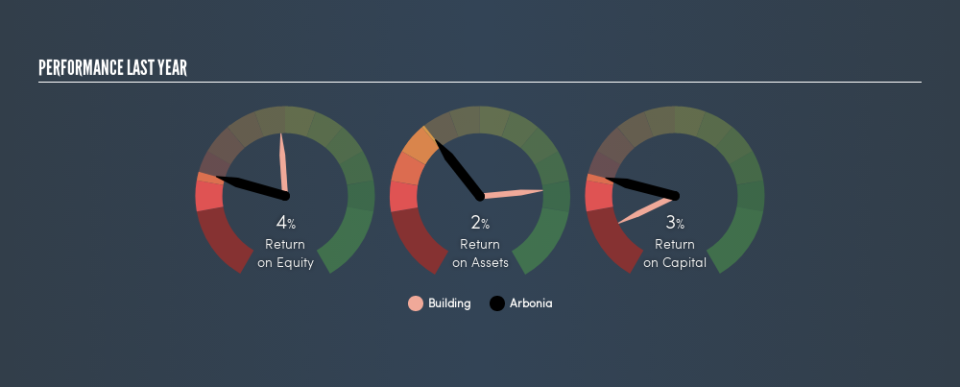Arbonia AG (VTX:ARBN) Might Not Be A Great Investment

Today we are going to look at Arbonia AG (VTX:ARBN) to see whether it might be an attractive investment prospect. Specifically, we'll consider its Return On Capital Employed (ROCE), since that will give us an insight into how efficiently the business can generate profits from the capital it requires.
Firstly, we'll go over how we calculate ROCE. Next, we'll compare it to others in its industry. Finally, we'll look at how its current liabilities affect its ROCE.
What is Return On Capital Employed (ROCE)?
ROCE is a measure of a company's yearly pre-tax profit (its return), relative to the capital employed in the business. Generally speaking a higher ROCE is better. In brief, it is a useful tool, but it is not without drawbacks. Renowned investment researcher Michael Mauboussin has suggested that a high ROCE can indicate that 'one dollar invested in the company generates value of more than one dollar'.
So, How Do We Calculate ROCE?
Analysts use this formula to calculate return on capital employed:
Return on Capital Employed = Earnings Before Interest and Tax (EBIT) ÷ (Total Assets - Current Liabilities)
Or for Arbonia:
0.029 = CHF36m ÷ (CHF1.6b - CHF380m) (Based on the trailing twelve months to June 2019.)
So, Arbonia has an ROCE of 2.9%.
View our latest analysis for Arbonia
Does Arbonia Have A Good ROCE?
When making comparisons between similar businesses, investors may find ROCE useful. Using our data, Arbonia's ROCE appears to be significantly below the 17% average in the Building industry. This performance is not ideal, as it suggests the company may not be deploying its capital as effectively as some competitors. Independently of how Arbonia compares to its industry, its ROCE in absolute terms is low; especially compared to the ~3.3% available in government bonds. Readers may wish to look for more rewarding investments.
Arbonia delivered an ROCE of 2.9%, which is better than 3 years ago, as was making losses back then. That implies the business has been improving. You can see in the image below how Arbonia's ROCE compares to its industry. Click to see more on past growth.
When considering ROCE, bear in mind that it reflects the past and does not necessarily predict the future. Companies in cyclical industries can be difficult to understand using ROCE, as returns typically look high during boom times, and low during busts. ROCE is only a point-in-time measure. Future performance is what matters, and you can see analyst predictions in our free report on analyst forecasts for the company.
Do Arbonia's Current Liabilities Skew Its ROCE?
Liabilities, such as supplier bills and bank overdrafts, are referred to as current liabilities if they need to be paid within 12 months. The ROCE equation subtracts current liabilities from capital employed, so a company with a lot of current liabilities appears to have less capital employed, and a higher ROCE than otherwise. To check the impact of this, we calculate if a company has high current liabilities relative to its total assets.
Arbonia has total assets of CHF1.6b and current liabilities of CHF380m. Therefore its current liabilities are equivalent to approximately 24% of its total assets. With a very reasonable level of current liabilities, so the impact on ROCE is fairly minimal.
The Bottom Line On Arbonia's ROCE
Arbonia has a poor ROCE, and there may be better investment prospects out there. Of course, you might find a fantastic investment by looking at a few good candidates. So take a peek at this free list of companies with modest (or no) debt, trading on a P/E below 20.
If you like to buy stocks alongside management, then you might just love this free list of companies. (Hint: insiders have been buying them).
We aim to bring you long-term focused research analysis driven by fundamental data. Note that our analysis may not factor in the latest price-sensitive company announcements or qualitative material.
If you spot an error that warrants correction, please contact the editor at editorial-team@simplywallst.com. This article by Simply Wall St is general in nature. It does not constitute a recommendation to buy or sell any stock, and does not take account of your objectives, or your financial situation. Simply Wall St has no position in the stocks mentioned. Thank you for reading.

